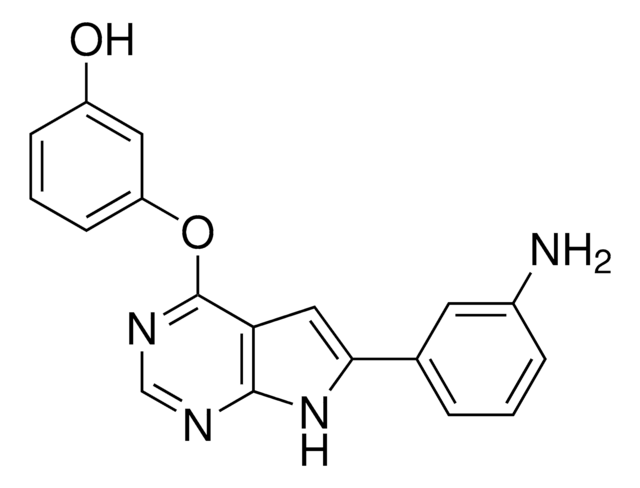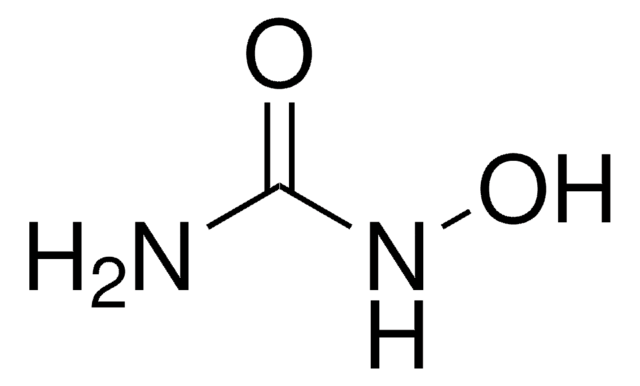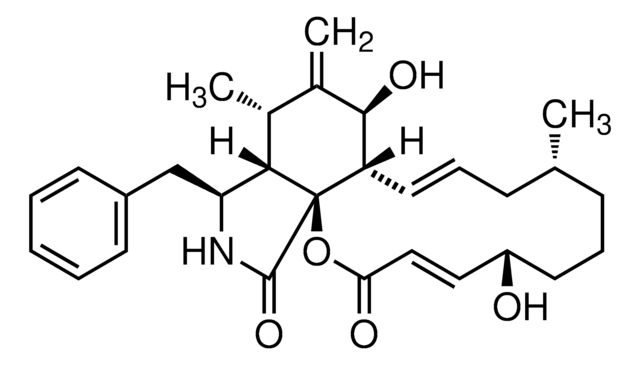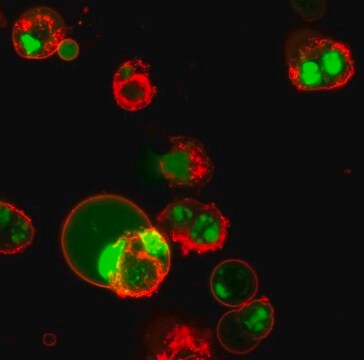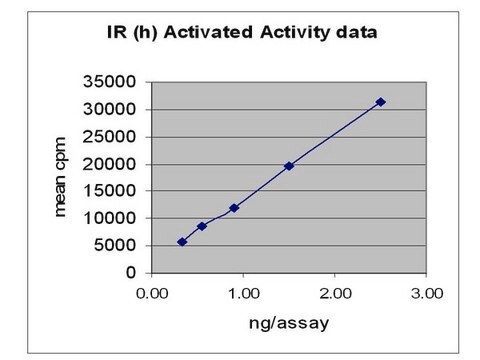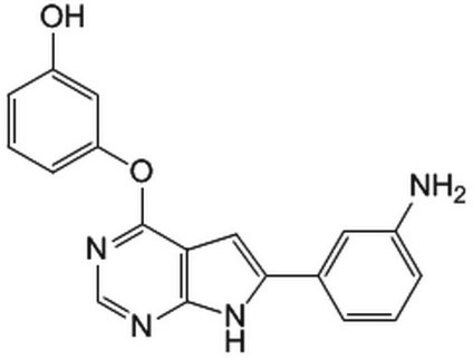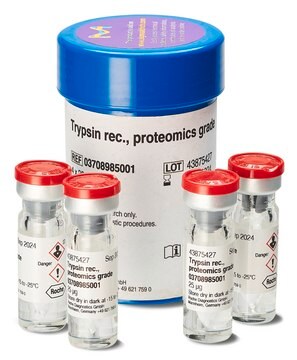217714
5-氨基-3-((4 -(氨基磺酰基)苯基)氨基)-N-(2,6-二氟苯基)-1H-1,2,4-三唑-1-硫代乙酰胺
The Cdk1/2 Inhibitor III, also referenced under CAS 443798-55-8, controls the biological activity of Cdk1/2. This small molecule/inhibitor is primarily used for Phosphorylation & Dephosphorylation applications.
同義詞:
5-氨基-3-((4 -(氨基磺酰基)苯基)氨基)-N-(2,6-二氟苯基)-1H-1,2,4-三唑-1-硫代乙酰胺, 5-氨基-3-((4-(磺酰胺)苯基)氨基)-N-(2,6-二氟苯基)-1H-1,2,4-三唑-1-硫代酰胺
登入查看組織和合約定價
全部照片(1)
About This Item
推薦產品
品質等級
化驗
≥95% (HPLC)
形狀
solid
製造商/商標名
Calbiochem®
儲存條件
OK to freeze
protect from light
顏色
white
溶解度
DMSO: 10 mg/mL
THF: soluble
acetone: soluble
運輸包裝
ambient
儲存溫度
2-8°C
InChI
1S/C15H13F2N7O2S2/c16-10-2-1-3-11(17)12(10)21-15(27)24-13(18)22-14(23-24)20-8-4-6-9(7-5-8)28(19,25)26/h1-7H,(H,21,27)(H2,19,25,26)(H3,18,20,22,23)
InChI 密鑰
ARIOBGGRZJITQX-UHFFFAOYSA-N
一般說明
一种可渗透细胞的三唑并二胺化合物,在各种人类癌细胞中均具有抗增殖特性(HCT-116,HeLa和A375细胞的IC50分别为20 nM,35 nM和92 nM)。作为Cdk1/细胞周期蛋白B和Cdk2/细胞周期蛋白A(IC50分别为600 pM和500 pM)的高效,可逆,ATP竞争性抑制剂,对VEGF-R2(IC50=32 nM),GSK-3β(IC50=140 nM)和一组其他八种激酶(IC50 ≥ 1 µM)具有选择性。
生化/生理作用
主要靶标
Cdk1/细胞周期蛋白B,Cdk2/细胞周期蛋白A
Cdk1/细胞周期蛋白B,Cdk2/细胞周期蛋白A
产物与ATP竞争。
可逆性:是
细胞可渗透性:是
靶标IC50:对于HCT-116,HeLa和A375细胞的抗增殖特性,分别为20 nM,35 nM和92 nM;针对Cdk1/细胞周期蛋白B和Cdk2/细胞周期蛋白A,分别为600 pM和500 pM
包裝
用惰性气体包装
警告
毒性:有害(C)
重構
复溶后,等分并冷冻保存(-20°C)。储备液在-20°C条件下可稳定保存6个月。
其他說明
Lin, R., et al. 2005.J.Med. Chem.48, 4208.
法律資訊
CALBIOCHEM is a registered trademark of Merck KGaA, Darmstadt, Germany
儲存類別代碼
11 - Combustible Solids
水污染物質分類(WGK)
WGK 1
閃點(°F)
Not applicable
閃點(°C)
Not applicable
分析證明 (COA)
輸入產品批次/批號來搜索 分析證明 (COA)。在產品’s標籤上找到批次和批號,寫有 ‘Lot’或‘Batch’.。
Ana Domingo-Muelas et al.
Cellular and molecular life sciences : CMLS, 80(1), 36-36 (2023-01-11)
Cell differentiation involves profound changes in global gene expression that often has to occur in coordination with cell cycle exit. Because cyclin-dependent kinase inhibitor p27 reportedly regulates proliferation of neural progenitor cells in the subependymal neurogenic niche of the adult mouse
Sungsoo Kim et al.
Scientific reports, 12(1), 16810-16810 (2022-10-08)
External signaling controls cell-cycle entry until cells irreversibly commit to the cell cycle to ensure faithful DNA replication. This process is tightly regulated by cyclin-dependent kinases (CDKs) and the retinoblastoma protein (Rb). Here, using live-cell sensors for CDK4/6 and CDK2
Yilin Fan et al.
Cell reports, 36(4), 109436-109436 (2021-07-29)
Contact inhibition of cell proliferation regulates tissue size and prevents uncontrolled cell expansion. When cell density increases, contact inhibition can force proliferating cells into quiescence. Here we show that the variable memory of local cell density experienced by a mother
Jenny F Nathans et al.
Science advances, 7(3) (2021-02-02)
The G1-S checkpoint is thought to prevent cells with damaged DNA from entering S phase and replicating their DNA and efficiently arrests cells at the G1-S transition. Here, using time-lapse imaging and single-cell tracking, we instead find that DNA damage
我們的科學家團隊在所有研究領域都有豐富的經驗,包括生命科學、材料科學、化學合成、色譜、分析等.
聯絡技術服務
